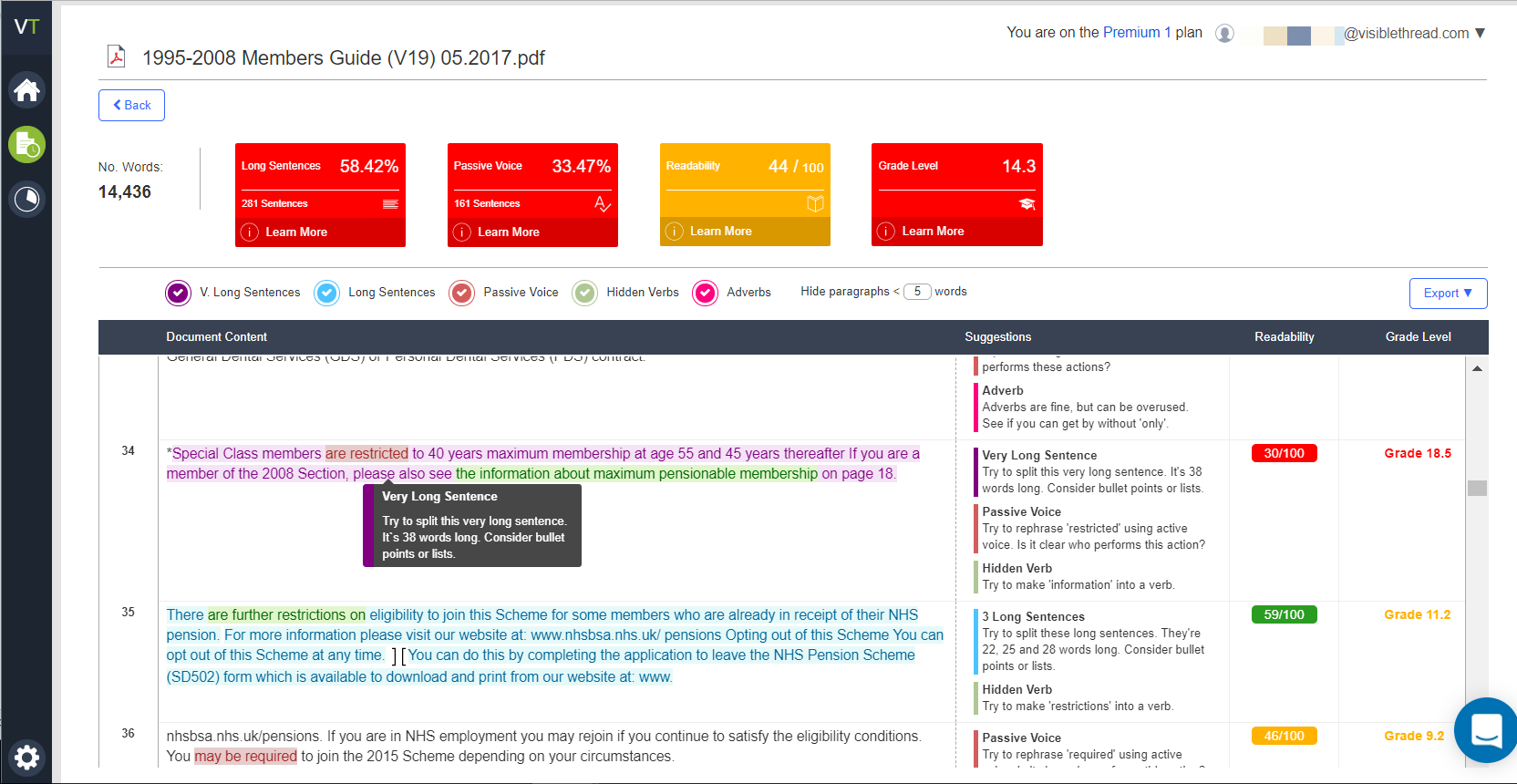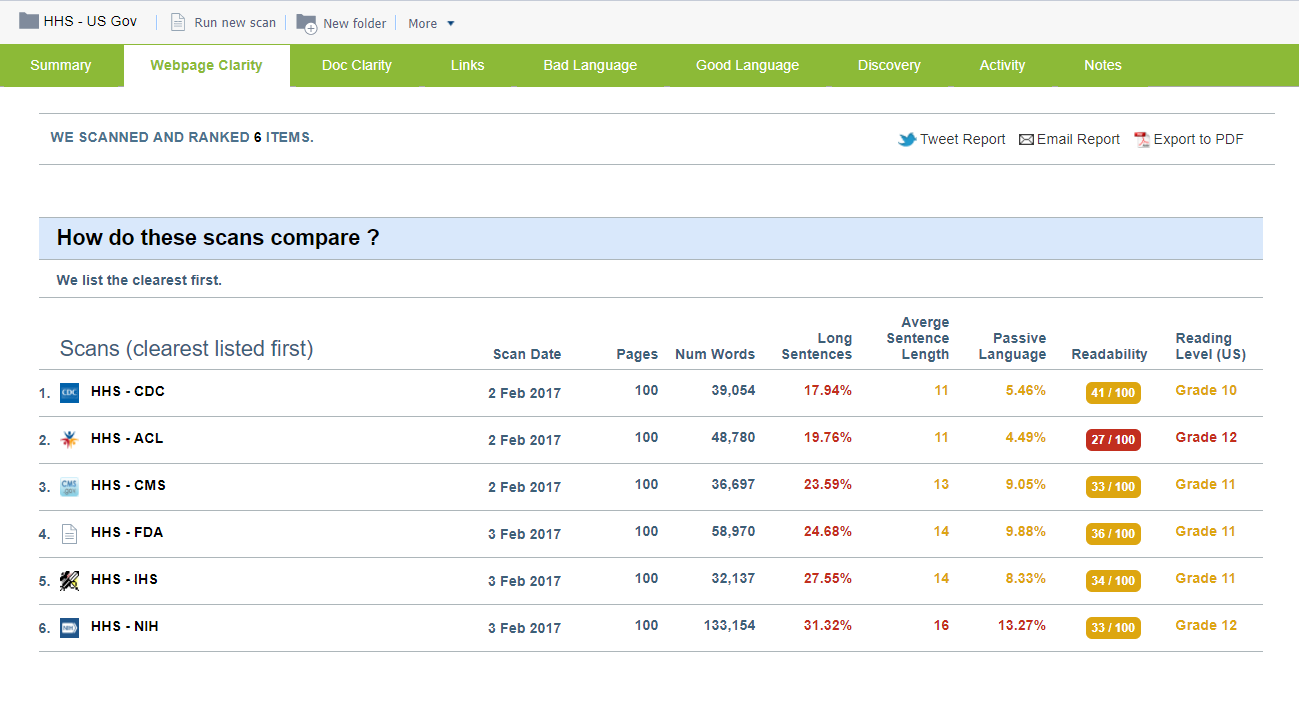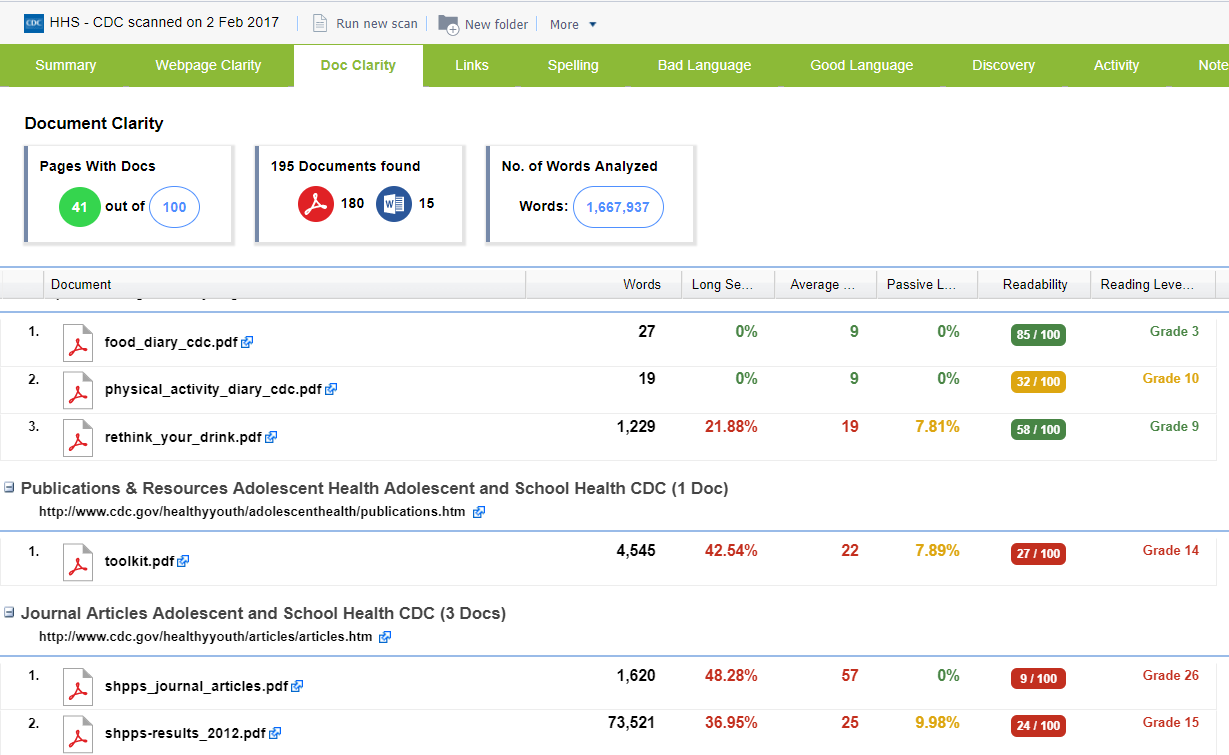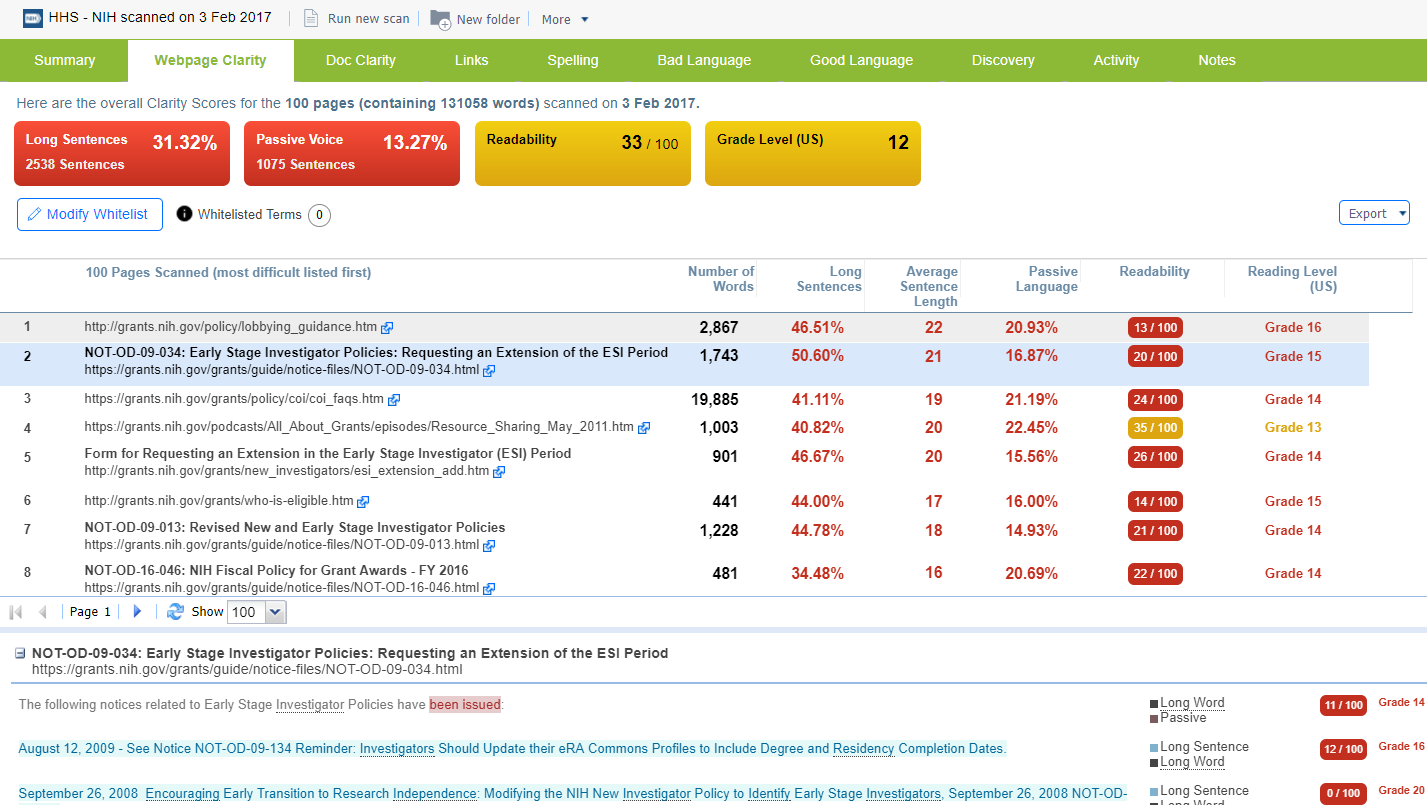Words matter. This is especially true in a regulated industry such as pharma in which the wrong word or context can get you in trouble with the FDA. At the same time, pharma also needs to balance staying compliant with delivering content that consumers can actually understand—that means not overloading them with medical terminology or jargon. In the past, companies would have to manually manage all of their content to ensure it meets all regulatory requirements and remains easy to understand. But, new options to sense check content for clear and plain language are emerging that makes this task much easier.
VisibleThread is a suite of software that offers marketers both readability and auditing tools. In addition to serving healthcare companies, VisibleThread is also being used by major enterprises in defense, aerospace, and financial services as well as government organizations and non-profits. It helps ensure their messages are pure, succinct, and engaging to their audience.
VisibleThread’s tools are mostly used in two different capacities. One potential use is by a company’s centralized publishing team, which are typically made up of communications teams, editorial teams, marketing teams, etc., so that they can audit large amounts of content, documents, webpages, or whatever else they produce. Another potential use is by the individual creator of content for a very lightweight mechanism to test their content before publishing it.
 For example, take into consideration the U.S. Department of Health and Human Services (HHS). VisibleThread’s web-based platform can perform audits, or scans, on different parts of HHS’s online offerings, including the CDC, FDA, CMS, and NIH. Users can choose how many webpages on each of those sites they want the platform to examine, either by specifying URLs or just looking at all of the pages found on the site. And then an examination of those webpages will measure a variety of factors including the number of words, the number of long sentences, the average sentence length, and the use of passive language. Based on those factors, and more, the platform will also output a readability score out of 100 and the estimated grade reading level.
For example, take into consideration the U.S. Department of Health and Human Services (HHS). VisibleThread’s web-based platform can perform audits, or scans, on different parts of HHS’s online offerings, including the CDC, FDA, CMS, and NIH. Users can choose how many webpages on each of those sites they want the platform to examine, either by specifying URLs or just looking at all of the pages found on the site. And then an examination of those webpages will measure a variety of factors including the number of words, the number of long sentences, the average sentence length, and the use of passive language. Based on those factors, and more, the platform will also output a readability score out of 100 and the estimated grade reading level.  Users can then jump onto the worse offending individual pages in order to fix the content. The platform will highlight the problem areas on that site, making it easy for the user to see what needs to be addressed. In addition to webpages, the platform can also examine any document posted online, such as PDFs and Word Docs. Beyond just clarity issues, the platform can also be set to search for “bad language” or “good language.” This helps companies to find compliance issues or any style issues they have. For instance, it can be used to help ensure a drug is always indicated for its approved use and there is no language suggesting any off-label uses. Or, it can be set to make sure you always use “doctor” instead of “physician,” if your company has a style preference for how the word should appear.
Users can then jump onto the worse offending individual pages in order to fix the content. The platform will highlight the problem areas on that site, making it easy for the user to see what needs to be addressed. In addition to webpages, the platform can also examine any document posted online, such as PDFs and Word Docs. Beyond just clarity issues, the platform can also be set to search for “bad language” or “good language.” This helps companies to find compliance issues or any style issues they have. For instance, it can be used to help ensure a drug is always indicated for its approved use and there is no language suggesting any off-label uses. Or, it can be set to make sure you always use “doctor” instead of “physician,” if your company has a style preference for how the word should appear.
 To learn more about VisibleThread and its potential uses by pharma marketers, PM360 spoke to the company’s CEO, Fergal McGovern.
To learn more about VisibleThread and its potential uses by pharma marketers, PM360 spoke to the company’s CEO, Fergal McGovern.
PM360: Beyond just providing a tool to better manage clear and compliant content, what is the value of VisibleThread to pharma marketers?
Fergal McGovern: Our founding mantra is that there is an engagement issue online. Marketers are focusing a lot on aesthetics, such as interaction design and UI design, but they’re really not focusing on the words and the language itself. The fundamental issue with hard-to-understand content is that readers either disengage or they cost you money, because they move on to different channels or other brands. So even though there is this current major push toward online engagement, it is being done without clear instructional text—without clarity around the meaning of the message. The result is a gobbledygook effect, which is symptomatic of non-engaging content. It damages your brand value.
When it comes to pharma, they have to remain compliant with FDA guidelines, which includes publishing important safety information with each drug. Considering that content can be quite scientific and medical, what can marketers do to increase the readability of this content so it doesn’t disengage patients?
We’re not saying that there is an automatic mechanism to do a cleanup of language without thinking. But if you think about complex language, it often relates to academic language—and many of us have been to academic institutions. Some of the fundamental characteristics of academic language is that the use of passive voice is prevalent. Often, there are multiple clauses, resulting in long, run-on sentences. These can exceed 20, 30, 40, sometimes even 50 words with multiple ideas enveloped in them. Now, irrespective of what the subject matter is, there is no reason why even with the most complex content that you can’t be compliant, while still simplifying the actual language.
Just using active voice versus passive voice makes it absolutely clear who needs to do what, when, and where. So, you can take the most technical subject matter and actually make it simpler, bringing the grade level from needing 40 years of education to understand the material, down to at least 15 or 16 years. We deal with many organizations who want to bring it down even lower than that—it all depends on the audience you are engaging with.
How is the readability level that your program outputs actually calculated?
Readability is based on what’s referred to as the Flesch Reading Ease Index, which was created originally by Rudolf Flesch in the 1950s. It’s based on two factors: One is the average syllable per word, and the second factor, which is slightly less weighted, is the density of long sentences. Ultimately, that’s driving a number between 0 and 100. Typically, we’d like to see above 50 on the scale. So, the higher you go, the easier and less cognitive overhead or overload it puts on the person’s brain.
Meanwhile, the grade-level metric is a derivative of the readability metric, and is something called the Flesch-Kincaid grade level. It’s derived from original work that the U.S. Navy did in the 1970s. The intention there was to make sure that soldiers in the field could easily understand instructions, because they were under heavy stress.
 What is the gold standard that organizations should aim to hit in terms of the metric you measure?
What is the gold standard that organizations should aim to hit in terms of the metric you measure?
There is not an absolute one size fits all, but we do have a general idea of what they should try to achieve. The gold standard in business communication would be on a readability level. Anything above 50 to 55, out of 100, is a good result. For grade level, one of our customers, a financial institution is very keen to make sure that the grade level of all published content is between 8 and 10. That can be a pretty ambitious charter, but it really is a good target. Then, as we look at long sentences and passive voice, typically we recommend getting it to 5% or less on long sentences. That’s based on millions of pages of analysis that we’ve done over the last few years.
We also see some companies arrive at the false assumption that since they are dealing with extremely complex subject matter—and more than likely extremely well-educated visitors—therefore they can afford to have extremely complex content. But extremely educated people are equally as prone to not interact and engage with complex content. Just because they’re educated doesn’t mean that they will spend the mental energy having to understand your message.
What kind of results have you seen from organizations that use this platform to manage or review their content?
One of our customers, the American Society of Clinical Oncology (ASCO), actually presented some of their results at a conference. For instance, they shared before and after stats for their Cancer.net site, which has a substantial amount of content that is very medically driven. Before they implemented VisibleThread, 29% of their content was at a grade 11 reading level and 12% was grade 12 and above. Then, once they ran the content through our platform, and started fixing this content, the amount of content above grade 11 decreased to 2%, which is a dramatic improvement.
What’s interesting about this is you can measure the outputs and you can measure the improvement, but actually the feedback they got from people writing in unprompted was very positive. One reader said, “Thanks for this clearly written presentation about PET-CT scans.” Another said, “Thank you for providing the information I was looking for about my upcoming colonoscopy. The information was easy to read and understand.”
But even though they were able to decrease the content’s grade level, we’re not saying it’s perfect. For instance, they went from having 34% long sentences to 17% percent, which probably still leaves room for improvement. But that did help improve their readability score from 48 to 53.
So, there are interesting stats around this. But it’s also a question of engagement as you look at clarity—it doesn’t stand in isolation. It also depends on how the website is structured, and it also has an interdependency between the appropriate prioritization of the paths and the user journeys that people are making.








